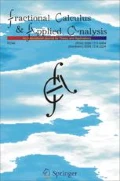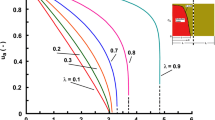Abstract
The aim of this article is to generalize the diffusion based adsorption model to a fractional diffusion and fractional adsorption model. The models are formulated as nonlinear fractional boundary value problems equivalent to a singular Hammerstein integral equation. The novelty is that not only the diffusion component of the model is fractionalized but also the adsorption part. The singular Hammerstein integral equation is solved by Sinc approximations. Specific numerical schemes are presented. Based on these solutions we are able to identify different regimes of adsorption diffusion processes controlled by fractional derivatives verified by experimental data. These regimes allow to classify experiments if examined with respect to their scaling behavior.
Similar content being viewed by others
References
A. Apicella, L. Nicolais, G. Astarita, and E. Drioli, Hygrothermal history dependence of moisture sorption kinetics in epoxy resins. Poly. Eng. Sci. 21 (1981), 18–22.
G. Baumann and F. Stenger, Fractional calculus and Sinc methods. Fract. Calc. Appl. Anal. 14, No 4 (2011), 568–622; DOI: 10.2478/s13540-011-0035-3; http://link.springer.com/journal/13540/.
H. Brunner, Collocation Methods for Volterra Integral and Related Functional Differential Equations. Cambridge University Press, Cambridge (2004).
M. Caputo and F. Mainardi, A new dissipation model based on memory mechanism. Pure Appl. Geophys. 91 (1971), 134–147.
J. Crank, The Mathematics of Diffusion. Oxford Univ. Press, Oxford (2009).
P. Delahay and I. Trachtenberg, Adsorption kinetics and electrode processes. J. Amer. Chem. Soc. 79 (1957), 2355–2362.
P. Delahay and Ch.T. Fike, Adsorption kinetics with diffusion controlthe plane and the expanding sphere. J. Amer. Chem. Soc. 80 (1958), 2628–2630.
D.D. Do, Adsorption Analysis. Imperial College Press, London (1998).
Z. Földes-Papp and G. Baumann, Fluorescence molecule counting for single-molecule studies in crowded environment of living cells without and with broken ergodicity. Cur. Pharm. Biot. 12 (2011), 824–833.
M. Friedrich, A. Seidel, and D. Gelbin, Measuring adsorption rates from an aqueous solution, AIChE J. 31 (1985), 324–327.
I.P. Gavrilyuk, P.F. Zhuk, and L.N. Bondarenko, Some inverse problems of internal-diffusion kinetics of adsorption. J. Math. Sci. 66 (1993), 2387–2390.
M. Giona and M. Giustiniani, Adsorption kinetics on fractal surfaces. J. Phys. Chem. 100 (1996), 16690–16699.
J.D. Goddard, History effects in transient diffusion through heterogeneous media. Ind. Chem. Res. 31 (1992), 713–721.
A.A. Kilbas, H.M. Srivastava, and J.J. Trujillo, Theory and Applications of Fractional Differential Equations. Elsevier, Amsterdam (2006).
T. Kwon, M. Min, H. Lee, and B.J. Kim, Facile preparation of water soluble CuPt nanorods with controlled aspect ratio and study on their catalytic properties in water. J. Mater. Chem. 21 (2011), 11956–11960.
C. Lubich, Convolution quadrature and discretized operational calculus: I. Numer. Math. 52 (1988), 129–145.
C. Lubich, Convolution quadrature and discretized operational calculus: II. Numer. Math. 52 (1988), 413–425.
J. McNamee, F. Stenger, and E.L. Whitney, Whittaker’s cardinal function in retrospect. Math. Comp. 23 (1971), 141–154.
Y. Meroz, I.M. Sokolov, J. Klafter, Subdiffusion of mixed origins: When ergodicity and nonergodicity coexist. Phys. Rev. E 81 (2010), 010101xxx1–010101xxx4.
R. Metzler, W.G. Glöckle, and Th. Nonnenmacher, Fractional model equation for anomalous diffusion. Physica A 211 (1994), 13–24.
R. Metzler and J. Klafter, The random walk’s guide to anomalous diffusion. Phys. Rep. 339 (2000), 1–77.
N. Quirke, Adsorption and Transport at the Nanoscale. CRC/Taylor & Francis, Boca Raton, Fla. (2006).
O.J. Redlich and D.L. Peterson, A useful adsorption isotherm. J. Phys. Chem. 63 (1959), 1024–1024.
H. Scher and E.W. Montroll, Anomalous transit-time dispersion in amorphous solids. Phys. Rev. B 12 (1975), 2455–2477.
A. Seri-Levy and D. Avnir, Kinetics of diffusion-limited adsorption on fractal surfaces. J. Phys. Chem. 97 (1993), 10380–10384.
F. Stenger, Numerical Methods Based on Sinc and Analytic Functions. Springer, New York (1993).
F. Stenger, Collocating convolutions. Math. Comp. 64 (1995), 211–235.
F. Stenger, Handbook of Sinc Numerical Methods. CRC Press, Boca Raton (2011).
B. Such, Th. Trevethan, Th. Glatzel, Sh. Kawai, L. Zimmerli, E. Meyer, A.L. Shluger, C.H.M. Amijs, and P. Mendoza, Functionalized truxenes: adsorption and diffusion of single molecules on the KBr(001) surface. ACS Nano 4 (2010), 3429–3439.
Y.J. Weitsman, A continuum diffusion model for viscoelastic materials. J. Phys. Chem. 94 (1990), 961–968.
Y.J. Weitsman and Ya-J. Guo, A correlation between fluid-induced damage and anomalous fluid sorption in polymeric composites. Comp. Sci. Tech. 62 (2002), 889–908.
Author information
Authors and Affiliations
Corresponding author
Additional information
Dedicated to Professor Nonnenmacher on the occasion of his 80th birthday
About this article
Cite this article
Baumann, G., Stenger, F. Fractional adsorption diffusion. fcaa 16, 737–764 (2013). https://doi.org/10.2478/s13540-013-0046-3
Received:
Published:
Issue Date:
DOI: https://doi.org/10.2478/s13540-013-0046-3




